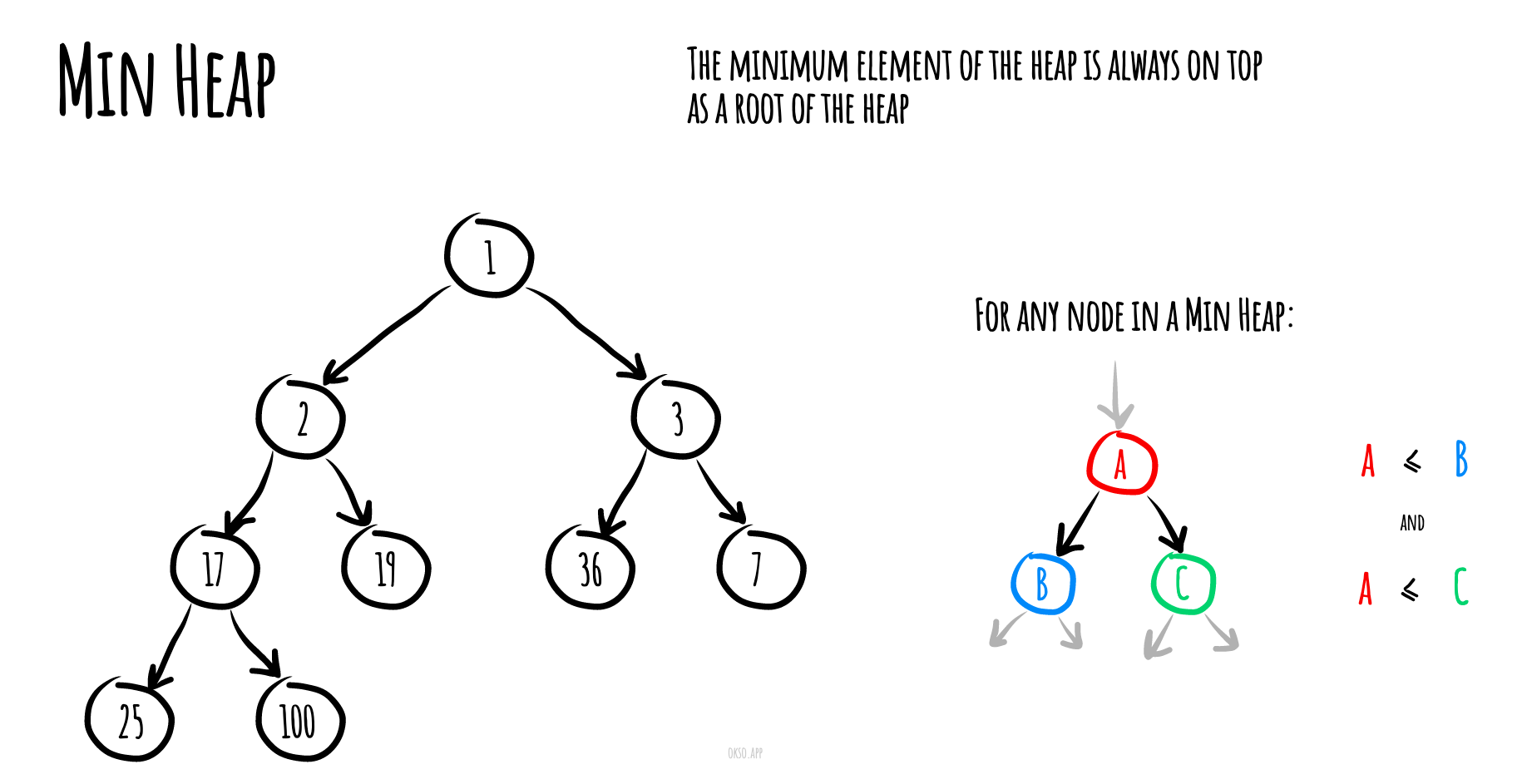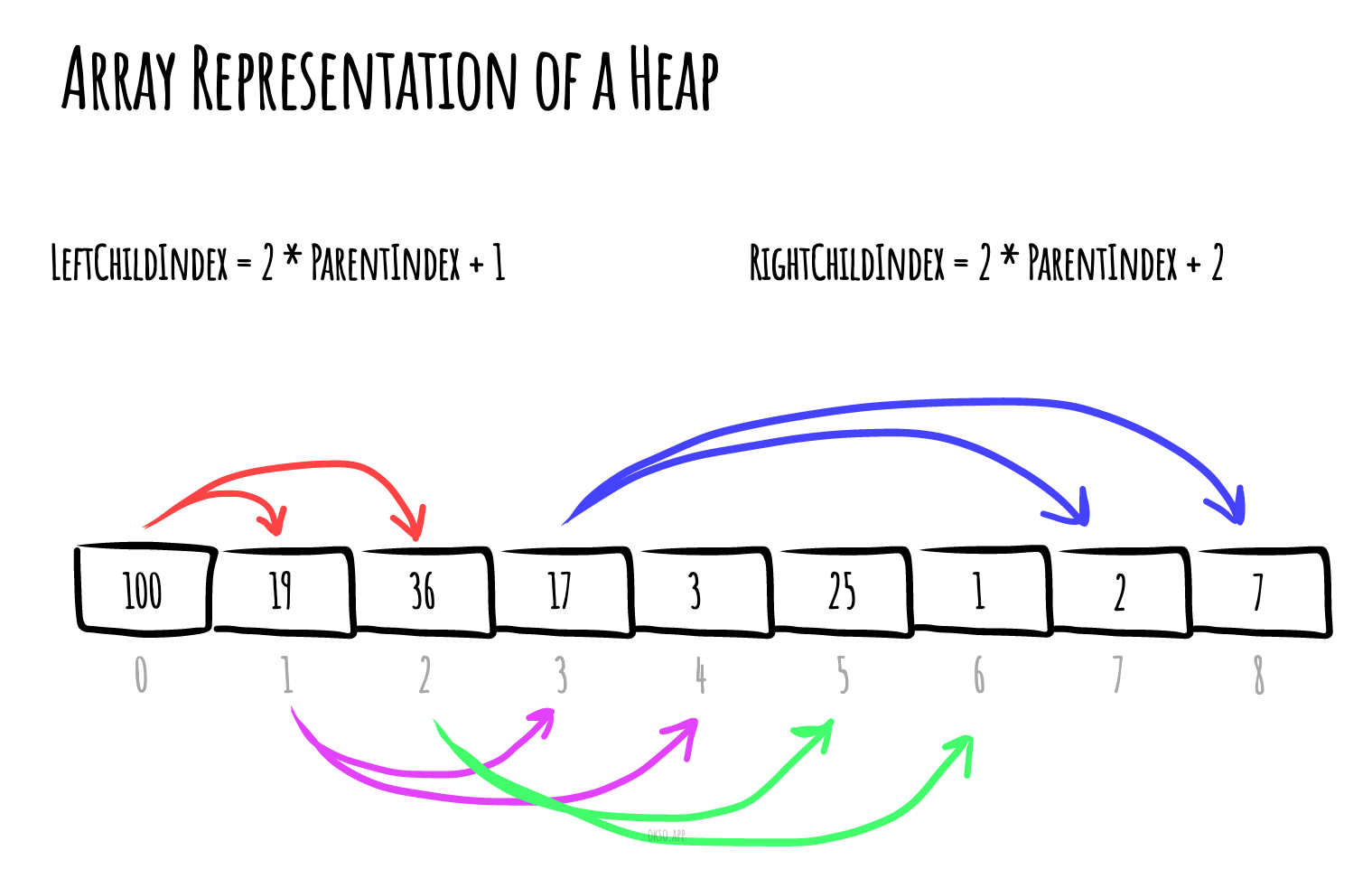堆 (数据结构)
在计算机科学中, 一个 堆(heap) 是一种特殊的基于树的数据结构,它满足下面描述的堆属性。
在一个 最小堆(min heap) 中, 如果 P 是 C 的一个父级节点, 那么 P 的 key(或 value)应小于或等于 C 的对应值.

在一个 最大堆(max heap) 中, P 的 key(或 value)大于 C 的对应值。


在堆“顶部”的没有父级节点的节点,被称之为根节点。
Heap 类
构造函数 constructor
1
2
3
4
5
6
7
8
9
10
11
12
13
14
15
16
|
constructor(comparatorFunction) {
if (new.target === Heap) {
throw new TypeError('Cannot construct Heap instance directly');
}
this.heapContainer = [];
this.compare = new Comparator(comparatorFunction);
}
|
getLeftChildIndex(parentIndex) 方法
1
2
3
4
5
6
7
|
getLeftChildIndex(parentIndex) {
return (2 * parentIndex) + 1;
}
|
getRightChildIndex(parentIndex) 方法
1
2
3
4
5
6
7
|
getRightChildIndex(parentIndex) {
return (2 * parentIndex) + 2;
}
|
getParentIndex(childIndex) 方法
1
2
3
4
5
6
7
|
getParentIndex(childIndex) {
return Math.floor((childIndex - 1) / 2);
}
|
hasParent(childIndex) 方法
1
2
3
4
5
6
7
8
9
|
hasParent(childIndex) {
return this.getParentIndex(childIndex) >= 0;
}
|
hasLeftChild(parentIndex) 方法
1
2
3
4
5
6
7
8
|
hasLeftChild(parentIndex) {
return this.getLeftChildIndex(parentIndex) < this.heapContainer.length;
}
|
hasRightChild(parentIndex) 方法
1
2
3
4
5
6
7
8
|
hasRightChild(parentIndex) {
return this.getRightChildIndex(parentIndex) < this.heapContainer.length;
}
|
leftChild(parentIndex) 方法
1
2
3
4
5
6
7
|
leftChild(parentIndex) {
return this.heapContainer[this.getLeftChildIndex(parentIndex)];
}
|
rightChild(parentIndex) 方法
1
2
3
4
5
6
7
8
9
|
rightChild(parentIndex) {
return this.heapContainer[this.getRightChildIndex(parentIndex)];
}
|
parent(childIndex) 方法
1
2
3
4
5
6
7
8
9
10
|
parent(childIndex) {
const parentIndex = this.getParentIndex(childIndex);
return this.heapContainer[parentIndex];
}
|
swap(indexOne, indexTwo) 方法
1
2
3
4
5
6
7
8
9
|
swap(indexOne, indexTwo) {
const tmp = this.heapContainer[indexTwo];
this.heapContainer[indexTwo] = this.heapContainer[indexOne];
this.heapContainer[indexOne] = tmp;
}
|
peek() 方法
1
2
3
4
5
6
7
8
9
10
11
12
13
14
|
peek() {
if (this.heapContainer.length === 0) {
return null;
}
return this.heapContainer[0];
}
|
poll() 方法
1
2
3
4
5
6
7
8
9
10
11
12
13
14
15
16
17
18
19
20
21
22
23
24
25
26
27
|
poll() {
if (this.heapContainer.length === 0) {
return null;
}
if (this.heapContainer.length === 1) {
return this.heapContainer.pop();
}
const item = this.heapContainer[0];
this.heapContainer[0] = this.heapContainer.pop();
this.heapifyDown();
return item;
}
|
add(item) 方法
1
2
3
4
5
6
7
8
9
10
|
add(item) {
this.heapContainer.push(item);
this.heapifyUp();
return this;
}
|
remove(item, comparator = this.compare) 方法
1
2
3
4
5
6
7
8
9
10
11
12
13
14
15
16
17
18
19
20
21
22
23
24
25
26
27
28
29
30
31
32
33
34
35
36
37
38
39
40
|
remove(item, comparator = this.compare) {
const numberOfItemsToRemove = this.find(item, comparator).length;
for (let iteration = 0; iteration < numberOfItemsToRemove; iteration += 1) {
const indexToRemove = this.find(item, comparator).pop();
if (indexToRemove === (this.heapContainer.length - 1)) {
this.heapContainer.pop();
} else {
this.heapContainer[indexToRemove] = this.heapContainer.pop();
const parentItem = this.parent(indexToRemove);
if (
this.hasLeftChild(indexToRemove)
&& (
!parentItem
|| this.pairIsInCorrectOrder(parentItem, this.heapContainer[indexToRemove])
)
) {
this.heapifyDown(indexToRemove);
} else {
this.heapifyUp(indexToRemove);
}
}
}
return this;
}
|
find(item, comparator = this.compare) 方法
1
2
3
4
5
6
7
8
9
10
11
12
13
14
15
16
|
find(item, comparator = this.compare) {
const foundItemIndices = [];
for (let itemIndex = 0; itemIndex < this.heapContainer.length; itemIndex += 1) {
if (comparator.equal(item, this.heapContainer[itemIndex])) {
foundItemIndices.push(itemIndex);
}
}
return foundItemIndices;
}
|
isEmpty() 方法
1
2
3
4
5
6
7
|
isEmpty() {
return !this.heapContainer.length;
}
|
toString() 方法
1
2
3
4
5
6
7
|
toString() {
return this.heapContainer.toString();
}
|
heapifyUp(customStartIndex) 方法
1
2
3
4
5
6
7
8
9
10
11
12
13
14
15
|
heapifyUp(customStartIndex) {
let currentIndex = customStartIndex || this.heapContainer.length - 1;
while (
this.hasParent(currentIndex)
&& !this.pairIsInCorrectOrder(this.parent(currentIndex), this.heapContainer[currentIndex])
) {
this.swap(currentIndex, this.getParentIndex(currentIndex));
currentIndex = this.getParentIndex(currentIndex);
}
}
|
该方法使用一个 while 循环来比较当前元素与其父元素,并在它们不满足正确的顺序关系时进行交换。循环会一直执行,直到当前元素到达正确的位置或成为堆的根节点。
heapifyDown(customStartIndex = 0) 方法
1
2
3
4
5
6
7
8
9
10
11
12
13
14
15
16
17
18
19
20
21
22
23
24
25
26
27
28
29
30
|
heapifyDown(customStartIndex = 0) {
let currentIndex = customStartIndex;
let nextIndex = null;
while (this.hasLeftChild(currentIndex)) {
if (
this.hasRightChild(currentIndex)
&& this.pairIsInCorrectOrder(this.rightChild(currentIndex), this.leftChild(currentIndex))
) {
nextIndex = this.getRightChildIndex(currentIndex);
} else {
nextIndex = this.getLeftChildIndex(currentIndex);
}
if (this.pairIsInCorrectOrder(
this.heapContainer[currentIndex],
this.heapContainer[nextIndex],
)) {
break;
}
this.swap(currentIndex, nextIndex);
currentIndex = nextIndex;
}
}
|
这个方法是用于执行堆向下调整的过程。它接受一个可选的参数 customStartIndex,用于指定开始堆化的索引位置,默认为 0。该方法比较父节点与其子节点,并根据堆的类型(最小堆或最大堆)与合适的子节点交换位置。然后,它继续对交换后的子节点进行相同的操作,直到元素在堆中达到正确的位置为止。
1
2
3
4
5
6
7
8
9
10
11
12
13
14
15
16
|
pairIsInCorrectOrder(firstElement, secondElement) {
throw new Error(`
You have to implement heap pair comparision method
for ${firstElement} and ${secondElement} values.
`);
}
|
这段代码用于检查堆中的元素对是否按正确的顺序排列。根据堆的类型,有两种情况:
对于 MinHeap,第一个元素必须始终小于或等于第二个元素。
对于 MaxHeap,第一个元素必须始终大于或等于第二个元素。
该函数接受两个参数,表示需要进行比较的元素对。然后,它抛出一个错误,并提供了一个错误消息,指示需要实现堆元素对比较的方法。错误消息中包含了第一个元素和第二个元素的值。
MaxHeap 类
pairIsInCorrectOrder(firstElement, secondElement) 方法
1
2
3
4
5
6
7
8
9
10
11
12
|
pairIsInCorrectOrder(firstElement, secondElement) {
return this.compare.greaterThanOrEqual(firstElement, secondElement);
}
|
这个方法用于检查堆元素对是否按照正确的顺序排列。根据堆的类型(最小堆或最大堆),第一个元素必须始终小于或等于第二个元素(最小堆),或者第一个元素必须始终大于或等于第二个元素(最大堆)。
MinHeap 类
pairIsInCorrectOrder(firstElement, secondElement) 方法
1
2
3
4
5
6
7
8
9
10
11
12
13
|
pairIsInCorrectOrder(firstElement, secondElement) {
return this.compare.lessThanOrEqual(firstElement, secondElement);
}
|


